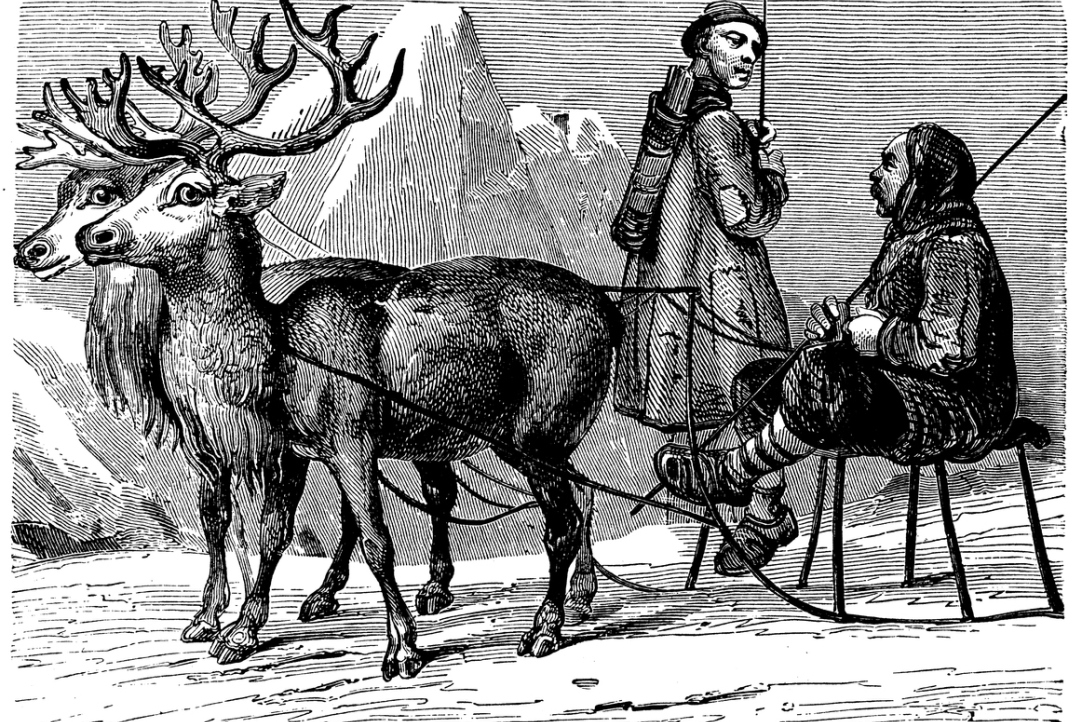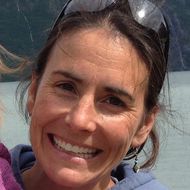Mapping Empire and Environment in Siberia: International Laboratory ‘Russia’s Regions in Historical Perspective’ Hosts Erika Monahan

How does an American researcher become interested in the history of enterprise in Siberia? Does knowing Alaska give one a good understanding of the Siberian temperament? If there is one book that provides a good history of Russia, what is it? HSE News Service asked these and other questions to Erika Monahan, Associate Professor of History at the University of New Mexico, who recently gave a talk at the seminar of the HSE International Laboratory ‘Russia’s Regions in Historical Perspective’.
Professor Monahan’s talk was entitled ‘Seeing Empire and Environment in Remezov's Khorograficheskaia Kniga’. It focused on perceptions of empire in cartographer Semyon Remezov’s Chorographic Sketchbook of Siberia.

I am very appreciative of the questions asked and connections made in the presentation. It is a real (and rare) gift to be able to share work and interest in 17th and 18th century Siberia with people who are as or better informed on that very topic, so I am so grateful for the opportunity.
My cooperation with HSE began through talking with Ekaterina Boltunova. She gave a very interesting paper at a conference in Tiumen in 2019. I engaged her in conversation after her presentation. When she began to talk to me about her work to engage regional universities in the HSE sphere I was very intrigued and excited about the opportunity to engage with Russian history graduate students. One of my goals for 2021 is to get back to archives in Russia, although this remains a complicated matter for the time being.
Siberia in the Fate of an American Scholar
I joined the UNM History department in 2008. My work for a small company in Russia during the 1990's sparked my interest in the history of enterprise in Russia. This, coupled with an interest in borderlands and frontiers, led me to write a dissertation that examines merchants and their practices in Siberia during the seventeenth and early eighteenth centuries. That project became my first book, The Merchants of Siberia: Trade in Early Modern Eurasia (Cornell University Press, 2016).
Over the years, my reactions to Siberia have sometimes shifted. I think lately—perhaps because I’m in Alaska and it’s winter, and I’ve just been working on a project on materiality, which I think has contributed to my thinking about people in Siberia centuries past in very visceral terms lately: how cold did they get? How many layers did they wear? How itchy was the wool? How did their tolerance of cold compare to ours?
I’ve also wondered about the physical work in their days—how much did they rest? How did they deal with daily aches and pains and sickness? Sometimes I think I perhaps creep up on thinking I am—for lack of a better word— relating to people, and then I think about the expectations for and of women in that context—a topic I’d like to understand better, but nonetheless, those kinds of thoughts serve to check the ‘relational imagination’ I might be entertaining.
Current Research and Teaching
I currently have three ongoing projects. The first is a book project, tentatively titled ‘Spinning Russia: Nicolaas Witsen and the Making of Russia’s Image in Europe’, which investigates the work of Nicolaas Witsen (1641–1717)—a Dutchman who devoted himself to amassing information about the peoples, places, and history of Eurasia—in order to reexamine circulation of knowledge about Russia and Eurasia in the early modern era. Investigating representations of Eurasian indigenous peoples and the cartographical traditions on which Witsen drew are components of this project.
Second, growing out of my first book, I am continuing to explore Bukharan merchants and imperial intermediaries in a broader Eurasian context and into the nineteenth century. Third, Bloomsbury Publishers has commissioned me to write a revised and expanded second edition of Lindsey Hughes’ The Romanovs: Ruling Russia, 1613–1917.
I also have a few pieces in the works dealing with Remezov. I am working on a piece about the Khorograficheskaia Kniga for a volume on materiality in Russian history. In the other pieces I am thinking about what the Khorograficheskaia kniga might offer us in terms of environmental history.
I teach courses on Rus’, Muscovy, the Russian Empire, the Soviet Union, and Russia from the ninth century to the present in a three-semester narrative sequence. I also teach courses on the history of the Russian Empire, Environmental History, and Russia in a larger European and global context. I teach graduate seminars in Early Modern Commerce (Cultures of Exchange; Capitalism: A Prequel) and Eurasian Borderlands. My teaching and research touch all of our department’s thematic concentrations, while my publications to date fit most squarely in our Frontiers & Borderlands and Politics & Economy concentrations.
Lessons from History and a History Book Recommendation
Selectively, history can certainly offer lessons in resilience. I like to think that having substantial historical knowledge can put one in a better position to take stock of the dynamics of the present, and one hopes that history can offer cautionary tales.
At the moment, if someone was going to read just one textbook of Russian history, I’d probably recommend Paul Bushkovitch’s A Concise History of Russia. I think it is a masterful synthesis of a broad sweep of history.
Ekaterina Boltunova
Head of the International Laboratory 'Russia’s Regions in Historical Perspective'
See also:
'We Wanted to Create an Opportunity for Intercampus Teams to Engage in Promising Studies'
HSE University has announced the winners of the Project Competition in Basic Science Research for Intercampus Departments. The competition, which the university is organising for the first time, will provide funding to 10 research teams working on five topics. Four of the winning projects will be implemented by new research departments formed as a result of the competition.
Research Reveals RNA's Role in Cancer Progression
An international group of scientists and medical specialists, including HSE researchers, examined the role played by microRNA (miRNA) and long non-coding RNAs on the progression of ovarian cancer. Having analysed more than a hundred tumour samples, they found that miRNA can prevent cell mutation while long non-coding RNAs have the opposite effect of enabling such mutations. These findings can help design new drugs which act by regulating miRNA concentrations. The study was published in the International Journal of Molecular Sciences.
‘We Managed to Bring Together Specialists in AI, Pure Mathematics, and Neurobiology’
In early September, the HSE University Faculty of Computer Science hosted the international conference Computer Methods of Cognitome Analysis. The event was organised by the International Laboratory of Algebraic Topology and Its Applications at the faculty.
Russian Researchers Propose New Approach to Studying Facial Emotion Recognition
Researchers of the HSE University and the Southern Federal University (SFedU) have tested a new method for studying the perception of facial emotional expressions. They suggest that asking subjects to recognise emotional expressions from dynamic video clips rather than static photographs can improve the accuracy of findings, eg in psychiatric and neurological studies. The paper is published in Applied Sciences.
Academics Started Working Even More During the Pandemic
Academics’ work week became even longer during the pandemic. This is true of researchers from different countries, independently of their gender and specialisation, an international research team with HSE University participation found. Their working time during the pandemic was 51 hours compared to the usual 40. The increased number of working hours per week seems to have become part of the new academic norm. The results of the study were published in the Plos One journal.
HSE Researchers Develop New Method for Analysing Genetic Admixture of Populations
Researchers of the HSE International Laboratory of Statistical and Computational Genomics together with their international colleagues have proposed a new statistical method for analysing population admixture that makes it possible to determine the time and number of migration waves more accurately. The history of Colombians and Mexicans (descendants of Native Americans, Spaniards and Africans) features two episodes of admixture that occurred about 350 and 200 years ago for Mexicans and 400 and 100 years ago for Colombians. The results were published in the Plos Genetics journal.
Scholars from Moscow and Vladivostok Join Efforts to Study Institutes and Preferences in Economic Behaviour
Applications from HSE departments for the ‘Mirror Laboratories’ open project competition are open until May 20. One of the ‘mirror laboratories’ successfully operating today was created as a result of a similar competition in 2020 by economists from HSE University and Far Eastern Federal University (FEFU) to study institutes and preferences in economic behaviour. Alexis Belianin, Head of the HSE International Laboratory for Experimental and Behavioural Economics, talked about how peers from Moscow and Vladivostok collaborate.
Stress Disorders More Prevalent among Doctors due to the Pandemic
Psychologists from HSE University have joined their peers from Ekaterinburg to look into the impact of the pandemic on the mental health of Russian doctors. They found that medical staff are suffering from stress, anxiety, and depression more often than before. The results of the study were published in International Journal of Environmental Research and Public Health.
International Laboratory of Landscape Ecology Opens at HSE University
The laboratory will be led by Robert Sandlersky, a specialist in energy and mass transfer and the study of other properties of landscapes via satellite imagery and Senior Research Fellow at the Severtsov Institute of Ecology and Evolution of the Russian Academy of Sciences. The HSE News Service spoke to Robert about the laboratory’s future activities.
New International Laboratory to Study Lighting Flashes and Volcanic Lightning
HSE University has launched a new International Laboratory for the Study and Assessment of Dangerous Geophysical Phenomena. Alexander Kostinskiy, Head of the Laboratory and Deputy Director of HSE MIEM, explains the laboratory’s future work, its important research and practical applications, and the role of international cooperation in the new laboratory.


